Soldering of contacts and wires
Soldering - the process of joining metals in the solid state with solders, which, when melted, flow into the gap, wet the surfaces to be soldered, and when cooled, solidify, form a soldered seam.
Soldering is performed at a temperature below the melting temperature of the materials of the parts to be joined. At the same time, the temperature of the solder used for soldering should be slightly higher than the melting point, and the temperature of the parts to be joined should be close to the melting temperature of the solder. Compliance with this condition is necessary to obtain such mobility of the solder, which ensures the filling of the gaps in the seams between the contact elements and the flow around their surfaces.
A quality soldering connection can only be achieved if the solder wets the contact surfaces of the elements to be connected, and also has high capillary properties and ensures filling of the gaps between the elements to be connected.
The metallurgical method of connecting parts using solder with a melting point below 450 ° C is called soft soldering. Adhesion of the solder to the metal occurs due to the adhesion of the solder to the metal. It should be noted that the melting point of solder for soft soldering at 450 ° C is assumed conditionally.
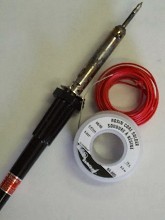 Making contact joints using solder with a melting point above 450 ° C is called soldering. Bonding of the solder to the metal in this case is due to both adhesion and diffusion of the solder into the metal.
Making contact joints using solder with a melting point above 450 ° C is called soldering. Bonding of the solder to the metal in this case is due to both adhesion and diffusion of the solder into the metal.
When soldering, there is almost no melting of the connected elements, so soldered connections are easier to repair.
Brazing makes connections between virtually any same metal or combination of dissimilar metals.
Copper is one of the metals that can be easily soldered. However, the addition of alloying elements to copper complicates the soldering process, since the presence of impurities in copper changes the properties of oxide films, which are an obstacle to the formation of a reliable connection. In addition, impurities in copper alloys react during soldering and form brittle joints. In this regard, when making contact connections, fluxes and solders must be carefully selected.
Aluminum brazing presents two major challenges. First, there is a refractory oxide film on aluminum, and second, aluminum has a high thermal conductivity with a relatively low heat capacity and a large coefficient of linear expansion. Therefore, in the process of soldering aluminum contact elements, the heating must be localized, the choice of flux must be made depending on the alloying additives introduced into the metal.
The characteristics of the various metals to be joined or their combinations predetermine both the technological process of soldering and solders, fluxes and equipment used in soldering.
Welded contact structure
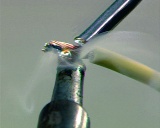 Brazing has a lot in common with fusion welding, but there are fundamental differences between the two. If during welding the main and additional metals are in the weld pool in a molten state, then the main metal does not melt during soldering.
Brazing has a lot in common with fusion welding, but there are fundamental differences between the two. If during welding the main and additional metals are in the weld pool in a molten state, then the main metal does not melt during soldering.
In general, soldering is a complex of metallurgical and physico-chemical processes occurring at the boundary between the base solid metal and the liquid metal — solder. Depending on the physico-chemical properties of the base material and the solder, as well as the conditions and method of soldering, the joint, formed between them, has a different structure. It is known that the condition for joining the base metal with the solder is adhesion. When wetting a clean metal surface with solder and its subsequent solidification, the following processes occur.
If the components that make up the solder do not interact with the base metal before dissolving in it, then intergranular bonds appear between the solder and this metal. The bond strength of the hardened solder to the base metal is close to the strength of the solder itself. This is determined by the fact that the solder fills all irregularities and micro-channels, which form a developed adhesion surface, significantly exceeding the visible contact surface.
In the event that the dissolution of one metal in another is possible at the soldering temperature or at lower temperatures, in addition to intercrystalline bonds, there is a diffusion of solder atoms into the soldered metal and vice versa. The mutual diffusion of the solder and the solder metal is extremely sensitive to temperature. Therefore, the development of this process depends on the soldering temperature and the duration of heating. At certain temperatures, the weld metal and solder components form intermetallic layers at the joint boundary.
The structure of the contact joint made by soldering is an area consisting of a layer of cast solder equal to the gap between the elements to be joined and surrounded on both sides by the products of the interaction of the solder with the base metals — intermetallic intermediate layers different compositions — and areas of mutual distribution.
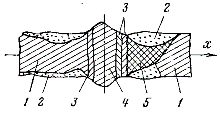
The structure of the soldered joint: 1 — connected wires; 2 — corrosion zones; 3 — intermetallic layers; 4 — solder; 5 — diffusion zone
Soldering of aluminum wires
Connection and branching of solid wires with a cross section of 2.5 — 10 mm2 by soldering are carried out after the ends of the core are previously connected with a double twist so that a groove is formed at the point where the cores touch. The junction is heated with the flame of a propane-butane burner or gasoline lamp to the temperature of the beginning of the melting of the solder. Then, with effort, rub the connecting surfaces with a soldering iron introduced into the flame. As a result of friction, the groove is cleaned of impurities and tinned when the joint is heated. In this way, the entire connection is sealed.
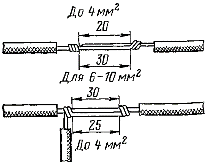
Soldering connection and branching of solid wires
Connection, termination and branching of insulated aluminum wires by soldering produced after step-by-step cutting of the contact areas of aluminum wires and their preliminary tinning. The ends of the veins are inserted into special forms, placing them in the middle and center of the tube part so that they touch each other. Protective screens are placed on the wires to protect the insulation of the connected wires from the action of the flame. Coolers are additionally used for large cross-sections of wires. The inner surfaces of the forms are pre-painted with cool paint or rubbed with chalk. The places where the wires enter the die are sealed with sheet or cord asbestos to prevent solder leakage.
Before direct flame soldering, the middle part of the die is heated, then solder is introduced into the flame, which by melting fills the die to the top of the hole.
The figure shows a connection prepared for soldering. Solder casting method was developed and used. With this method, prepared veins are laid with chamfers at an angle of 55 °. shape, leaving a distance between them of about 2 mm, the remaining operations of preparing the wire for connection are similar to those performed in fusion connection.
In the crucible, 7-8 kg of solder is melted and heated to about 600 ° C (to avoid rapid cooling). Between the crucible and the place where the solder is poured, a solder drain pan is installed, which is attached to the exposed parts of the wires.Solder is poured into the mold through the sprue hole until the edges of the cores are melted and the mold is filled. It is recommended to stir the solder and scrape the oxide film from the ends of the cores with a scraper. The soldering time does not exceed 1 — 1.5 minutes.

Stranded wires with forms mounted on them, prepared for soldering: 1 — wire insulation, 2 — protective screen, 3 — form, 4 — laid wire, 5 — asbestos seal.
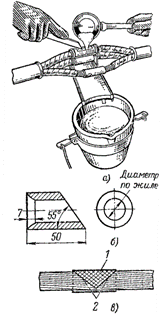
Connection of aluminum cable conductors by soldering by pouring molten solder: a — general view of the soldering process, b — template for decorating the ends of the wires; c — ready connection, 1 — solder, 2 — soldering points
Soldering of copper wires
The technology for connecting and terminating copper wires by soldering is the same. Soldering of wires with a cross-section of 1.5 — 10 mm2 is performed with a soldering iron, and with a cross-section of 16 — 240 mm2 — with a propane-butane torch or blowtorch; the soldering process consists of dipping in molten solder or pouring molten solder onto the soldering point.
Connection and branching of copper wires up to 10 mm2 by soldering is carried out after preparing their contacts. The veins are twisted, covered with rosin, the soldering point is heated with a soldering iron by melting the solder at the soldering point or by immersing the connection in a soldering bath. After the joint is moistened with solder and the gaps between the soldered ends are filled with it, the heating of the joint stops.
Connection and branching of copper wires with a section of 4 — 240 mm2 by soldering with the use of contact fittings, it is carried out by irrigation.For this purpose, solder in graphite or steel crucibles is heated in an electric or gas furnace to a temperature of 550-600°C.
Wires prepared for connection or termination are pre-tinned and then placed in a sleeve or ferrule. The conductor joint is located in the middle of the sleeve. When finished, the core is inserted into the bit so that its end is flush with the end of the pipe section of the tip. To avoid leakage of solder onto the core, asbestos is wound between the end of the sleeve (tip) and the edge of the insulation. The joint is horizontal. Irrigation of the solder continues until the volume between the core and the tip is filled, but not more than 1.5 minutes. At the end of soldering, immediately (until the solder cools down) wipe the sleeve with a cloth moistened with soldering ointment, expelling and smoothing solder stains.
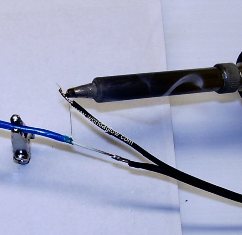
Soldering different metal wires is done using the same technology as connecting two aluminum wires. When preparing the ends of aluminum wires for soldering, their ends are beveled at an angle of 55O or step cut, after which the ends are tinned. Soldering is done by direct fusion in the mold or by casting with pre-melted solder. The connection and branching of aluminum stranded and solid wires can also be done in tinned copper bushings.
